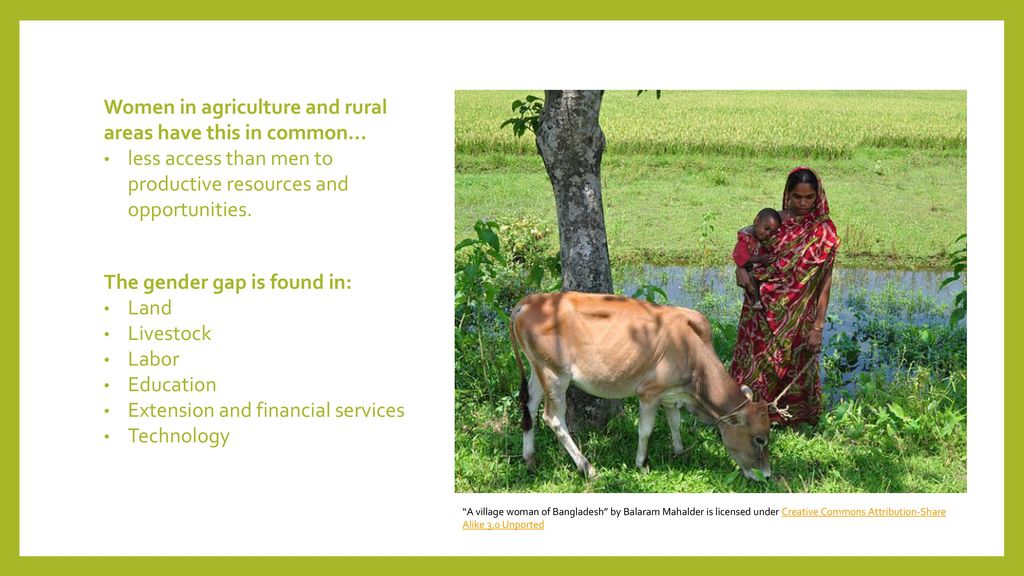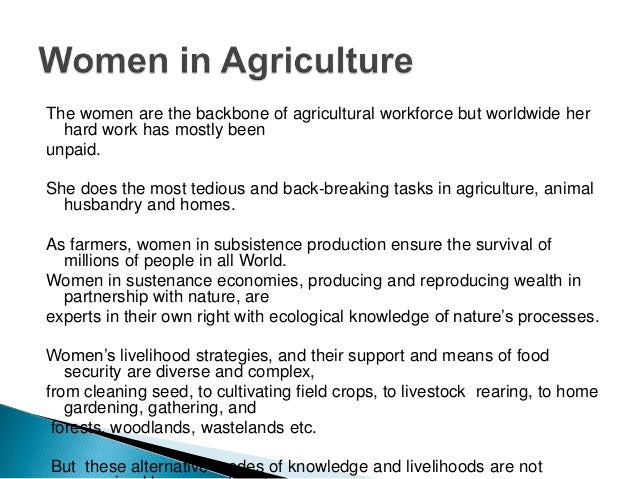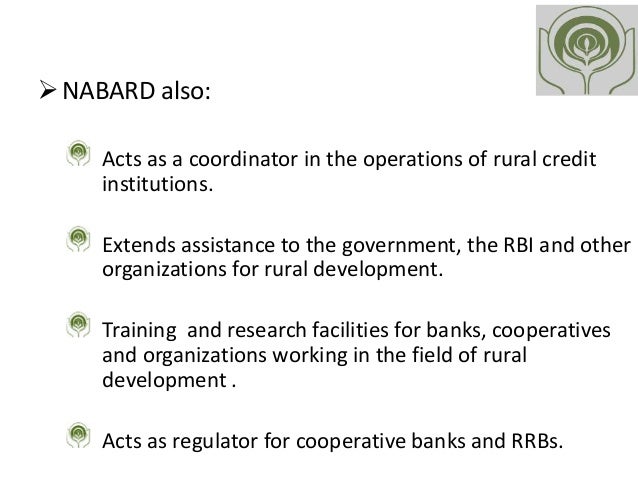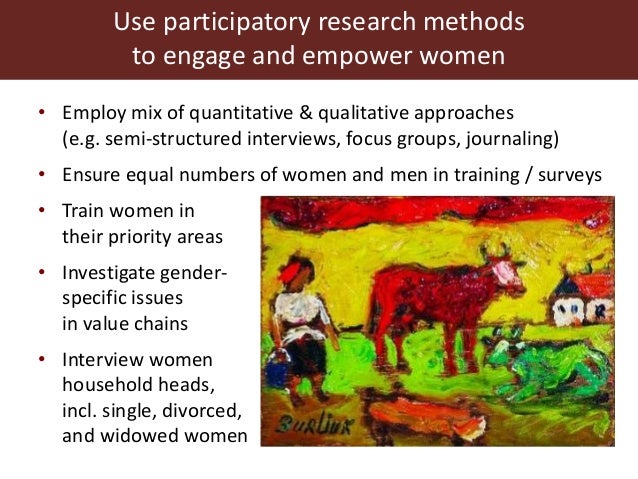ROLE OF WOMEN IN AGRICULTURE AND RURAL PROSPERITY
Relevance:
Sociology:
Rural and Agrarian transformation in India:
- Programmes of rural development, Community Development Programme, cooperatives, poverty alleviation schemes.
- Green revolution and social change.
G.S paper I:
- Role of women and women’s organization, population and associated issues, poverty and
- developmental issues,
G.S paper III: Agriculture
Women’s role in agriculture:

- Women have been instrumental in agricultural development and rural prosperity. Rural women play a vital role not only in crop planning and cultivation but also in high-value activities like horticulture, primary food processing, livestock rearing, fisheries and cottage industries.
- Agricultural sector contributing about 15.5 per cent of GDP in India is a female intensive activity. Women pursue multiple farm operations for producing the agricultural crops, rearing animals, and also work for wages in agricultural or other rural enterprises.
- Women are involved in all aspects of agriculture, from crop and seed selection to harvest and post-harvest management, marketing, and processing.
- According to estimates, the agricultural sector employs about 4/5th of all economically active women. Women when compared to men are engaged in much larger numbers in dairying and animal husbandry.

- The contribution of female workers and farmers has been much larger in agriculture and allied activities than the men.
- They also engage themselves in collecting fuel and water, engaging in trade and marketing, caring for family members and maintaining their homes. Though national accounts do not classify many of these activities as economically active employment, they are vital and essential to the well-being of rural households.
Concerns:
Low economic participation:
- The Agriculture Census, 2015–16 has revealed that the share of female operational holders has increased from 12.79 per cent in 2010–11 to 13.87 per cent in 2015–16. In terms of the operated area, the share of women increased from 10.36 per cent to 11.57 per cent.
-
- This signifies that more and more females are participating in the management and operation of agricultural lands but the absolute number continues to remain very low.
- According to NABARD’s estimates, women’s participation in wages/salaried activities was dismally low. A majority were attending to domestic duties and not engaged in any economic activity.
- The NABARD’s survey indicated a huge gender difference in the engagement and activities for employment in rural areas.

-
- While over one-fourth of the males were either self-employed including farmer,s only one-twentieth (4.8 per cent) of women respondents were self- employed.
- The percentage of males working as regular salaried or wage employees stood at 14 per cent as against only 3.2 per cent of females.
- The number of women in the total workforce in India is only 27 per cent, and almost 20 million women have withdrawn from the workforce during 2005 and 2012.

- Women’s contribution to economic activity and development in India stands at about 17–18 per cent (World Bank estimates) which is less than half the global average. India ranks 120th among 131 countries so far as women workforce participation is concerned.
- This implies that a huge population in rural India is still not economically utilised for better output.
Disadvantageous position:
- Although women have been contributing dominantly in the rural labour force, they are marginalised and disadvantaged in wages, land rights and representation in group activities.
- Women have very limited access to productive resources which consequently limits their productivity.
- The jobs in rural areas have been decreasing and not enough rural women have been able to make the transition to working in urban areas due to factors like lack of skills, low level of connectivity and safety measures for women workers willing to work in the cities.

Significance of women participation:
- Women participation is a must for an inclusive and sustainable economy of a nation. India cannot think of a vibrant economy and prosperous society when 50 per cent of the population is not involved fully in the various economic activities.
- Women’s economic empowerment is closely connected with poverty reduction as women also tend to invest more of their earnings in their children and communities. Increase in the incomes of women members in the family has increased the access to food and finance, and benefited their families as well as communities.
-
- The All India Rural Financial Inclusion Survey 2016–17 indicated that women have equal and very strong financial knowledge and have better positive financial attitude than their male counterparts.
- The estimates suggest the GDP growth in India can be boosted by 1.5 percentage points to achieve nine per cent growth per annum by facilitating 50 per cent of women joining the workforce in the country.
- The 2015 report titled “Power of Parity” by renowned consultancy firm Mckinsey states that India could add $700 billion of additional GDP in 2025, upping the country’s annual GDP growth by 1.4 percentage points by bolstering gender parity. About 70 per cent of the increase could come from raising India’s female labour force participation rate by 10 percentage points.
- According to IMF research raising women’s participation in the workforce to the level of men can boost Indian economy by 27 per cent.
Way forward:
Mobilizing the Rural Women:
- There is the need to mobilize women into Self Help Groups (SHGs) on the line of the National Rural Livelihood Mission.
-
- The National Rural Livelihood Mission of the Ministry of Rural Development has had a considerable impact on the rural development of India by mobilizing women into Self-Help Groups and providing capitalization support to such SHGs.
- Apart from SHGs, 63 lakh women farmers were also provided support for livelihood interventions.
Role of Financial Institutions:
- The banking and other financial institutions need to proactively reach out to SHGs for financial empowerment. The credit flow for working capital and other resources of the SHGs need to be augmented to make them more vibrant for participating in the prosperity of rural India.
Creating an ecosystem for empowerment:
- There is the need to provide an opportunity for poor rural women to have access to skills, markets and business development services.
Skill Development:
- One of the critical gaps that often lowers the employability of women and their efficiency and quality output at workplace is low skilling levels in women. The Skill India Mission needs to map such requirements and design tailor-made hands-on training modules for imparting skills to the willing women workers relevant to the prospective employers.
Business development support:
- Out of box initiatives like subsidised loans for businesses led by women, mentoring entrepreneurs and providing market access can have a far-reaching impact on women empowerment.
Social and Behavioural Change:
- The developmental interventions will fall short unless the social attitudes don’t change.
- The social researches have established that the women tend to drop out in response to family pressures even after completing the skill programmes and consequently getting jobs. Hence, the developmental efforts need to be suitably complemented by changing the social norms around marriages, work and household duties.
- India needs to evolve a social revolution to realise the development potential of the women workforce. The trend of women attending only domestic works will have to be reversed. Globally the societies developed and became prosperous by valuing contributions of girls and women in making societies.
Safety aspects:
- The comfort in commuting and safety while travelling will go a long way for empowering the women workforce in rural areas. The Government needs to work to provide better connectivity.
-
- In Tamil Nadu, a safe working environment has been able to encourage women to work in garment manufacturing, far from their village and homes.
- The availability of safe hostel facilities for their stay has encouraged their parents to allow them to work and stay away from home.

